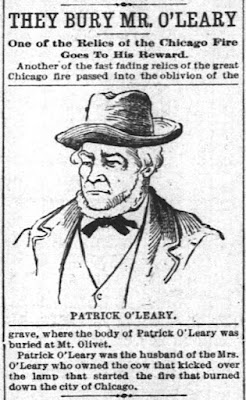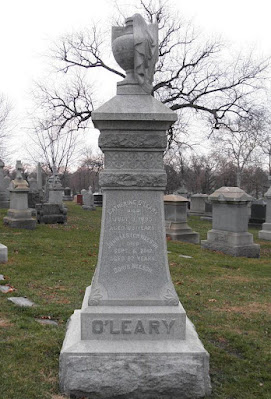The 150th anniversary of the Great Chicago Fire this month focused attention on many aspects of the “great conflagration” that consumed a significant portion of Chicago between October 8 and 10, 1871. The story of Mrs. Catherine O’Leary and her cow kicking over a lantern (as depicted by Norman Rockwell above) first surfaced before the flames were extinguished, and although she was cleared of any involvement in the fire just two months later, the legend has endured to this day. During her lifetime, the burden of blame had a profound effect on Mrs. O’Leary, forcing her to largely withdraw from public life, and dying with a heavy heart in 1895. In this third and final installment of Chicago Fire Stories, we share the facts of her life before, during, and after the Fire.
Early Years
Catherine Donnigan (other sources spell it Dunagan or Dunnigan) was born in County Kerry in southwest Ireland in 1827. Nothing is known of her childhood, but Kerry was known for its dairy cows, so she would have no doubt been introduced to that business at a young age. She married Patrick O’Leary, nine years her senior and also from Kerry, and endured the Great Hunger (known as the Irish Potato Famine outside of Ireland) which hit the south and west portions of Ireland especially hard from 1845 into the early 1850s.
The O’Learys were part of a huge influx of residents emigrating from Ireland, escaping the Great Hunger for the promise of a better life in the United States. By the mid-1850s, they had settled in Chicago where their eldest child, a daughter Mary, was born in 1857. Two sons, Cornelius (known as “Puggy”) and James Patrick, followed in 1860 and 1863 respectively. Both sons were baptized at Church of the Holy Family, founded in 1857 on 12th Street (now Roosevelt Road) at May Street. The boys later attended school there, the parents paying 50 cents a month each for their tuition.
In 1864, the O’Learys purchased the property at 137 DeKoven Street for $500, an indication they had found some modest success while living in Chicago. Two more children followed – a daughter Catherine in 1866 and a son Patrick in March 1871. The property comprised two separate houses which abutted each other, the O’Learys occupying the smaller rear structure, while renting out the larger front house with two rooms to a family named McLaughlin. The back of the property was occupied by a small barn measuring 16 by 20 feet, where Catherine O’Leary maintained her dairy business, consisting of six cows, along with a horse and wagon for making deliveries.
The Fire
Just before the fire, the
O’Learys had two tons of hay and two tons of coal delivered to the barn to
prepare them for winter. On October 8, 1871, the day of the fire, Mrs. O’Leary
tended to her cows late in the afternoon and then fed her horse about 7:00pm
before retiring for the evening. The entire family was in bed by about 8:00pm,
well before the fire commenced shortly after 9:00pm. They were alerted by a
neighbor banging on their door that the barn was ablaze; by the time they arose
and went outside, it was too late to save the animals and the contents of the
barn. A neighbor saved a calf, and one cow that had been tied up outside got
away, never to be seen again. Patrick successfully saved the house by dousing
it with water, but as Catherine later noted, she lost her entire dairy business
when the barn went up in flames.
The first mention of the fire starting when a cow kicked over a lantern while a woman was milking appeared in the Chicago Evening Journal on October 9, before the fire had burnt itself out. Other newspapers soon picked up the story and immediately identified Catherine O’Leary, the owner of the barn, as the culprit.
In late November, the Board of Police and Fire Commissioners launched an official inquiry to determine two things – the exact cause of the fire and the appropriateness of the response of the Chicago Fire Department. Fifty witnesses were interviewed over the next two weeks, including both Catherine and Patrick O’Leary and several of their neighbors. The story was consistent – the fire did begin in the O’Leary barn, but all members of the family were in bed asleep at the time the fire commenced. Various theories were introduced but no one could conclusively state the cause of the fire.
On December 12, 1871, just two months after the fire, the Board of Police and Fire Commissioners issued their findings. The report noted, in part:
“There is no proof that anybody had been in the barn after nightfall that evening. Whether it originated from a spark blown from a chimney on that windy night, or was set on fire by human agency, we are unable to determine. Mr. Leary, the owner, and all his family, prove to have been in bed and asleep at the time.”
(Note regarding “Leary”: Irish names at the time were often shown without the leading O or Mc).
After the Fire
With the official
report clearing Mrs. O’Leary of any involvement in the start of the fire, it is
rather surprising that the story didn’t simply die away and disappear with the
fire rubble being cleared from the streets. But it didn’t, and that caused
immediate problems for the O’Leary family. Numerous photos taken shortly after
the fire confirm that people flocked to DeKoven Street to see the site of the
barn and the surviving O’Leary house. The image shown below, is particularly
interesting as it shows the only west-facing window in the O’Leary portion of
the house boarded up, perhaps to maintain some level of privacy and keep the
curious from peeking in.
The McLauglins, who rented the front house, moved out within two days of the fire. The O’Learys moved in early 1874, relocating to Dashiel Street (now Union Avenue) near 41st Street, close to the Chicago Stockyards. They sold the DeKoven Street property in 1879 for $1,150. The new owners tore down the original house and replaced it with a more substantial masonry building, that soon sported a plaque noting the site as the place of origin of the fire.
Newspapers published articles every year on the anniversary of the fire, and Mrs. O’Leary was almost always mentioned as though the official inquiry clearing her had never taken place. In articles where the cow story was discounted, it was still discussed, keeping the O’Leary name alive, and making it impossible for Mrs. O’Leary to return to any form of the normal life she had known prior to the fire. She largely became a recluse and understandably denied requests for interviews; she was even offered opportunities to appear as what amounted to a carnival side show. Books and songs kept the story alive as well, including the book shown below, published for the tenth anniversary of the fire in 1881.
Her life took yet another tragic turn in August 1885. Puggy, her eldest son, had a violent altercation with a former love interest, Mary Snyder (or Campbell), who some said had given birth to a child that died soon after, naming Puggy as the father. During the incident, he pulled a gun and shot Mary dead. She was accompanied by Puggy’s older sister, Mary Scully, who was also shot and died the next day at the age of just 28. Puggy fled town but was soon captured in Kansas City. After a speedy trial, he was sentenced to 40 years, and was sent to Joliet Prison. In December 1889, he was transferred to an insane asylum.
The O’Learys’ second son James was far more successful in life. After a few years working in the Stockyards, where he earned the nickname “Big Jim,” he opened a saloon at 4183 S. Halsted Street, that featured Turkish baths, a restaurant, a billiard room, and a bowling alley. He opened a gambling operation in the rear of the building, and in time established himself as a gambling boss in Chicago.
He became a multi-millionaire and built a mansion (shown below) for his family, which still stands at 726 W. Garfield Boulevard. (He closed the operation in 1921 and died in 1925, but in an ironic twist of fate, the saloon building was destroyed in the 1934 Union Stockyards Fire – the largest fire in Chicago since the Great Fire of 1871.)
Patrick and Catherine O’Leary later purchased a house at 5133 S. Halsted Street. In September 1894, Patrick O’Leary was returning home, exiting the Halsted streetcar near his residence when he started to feel unwell. He made it to the front stoop of his house where he collapsed. His children carried him inside, but he was dead before they could get him to the couch. A large Irish wake with many “Kerry men” present took place, and he was interred in the family plot in Mount Olivet Cemetery.
Catherine O’Leary, who had been “feeble” for a few years, died in July 1895, still unable to separate herself from the story of her cow. Her obituary in the Chicago Tribune bore the headline:
“MRS. O’LEARY IS DEAD
-
SHE WAS NOTED
PRINCIPALLY BECAUSE OF HER COW.
That Milk-Producing
Animal Caused the Fire That Devastated the City in 1871”
Later Years
Catherine O’Leary was laid
to rest, but not the story of her cow. Just three years after she died, a
Vaudeville star wrote a set of words to the popular song of the time, A Hot
Time in the Old Town, perpetuating the O’Leary myth:
“One dark night, when
we were all in bed,
Mrs. O’Leary left a
lantern in the shed.
And when the cow
kicked it over,
She winked her eye and
said,
There’ll be a hot time
in the old town tonight!”
In 1911, on the fortieth anniversary of the fire, Michael Ahern, the last surviving reporter who had covered the Chicago Fire, recanted his story. He claimed that he was one of several reporters who simply made up the story, when the actual cause of the fire could not be quickly determined. Despite his confession, it did little to stop the story that was now a part of Chicago legend.
An additional 60 years would have to pass before the matter was put to rest once and for all. In October 1997, Alderman Ed Burke introduced a resolution before the City Council officially exonerating Mrs. O’Leary of any involvement in the fire. The resolution concludes:
“WHEREAS, Although contemporary research appears to vindicate Mrs. O’Leary, she has unfairly remained vilified and maligned by history; now, therefore
“BE IT RESOLVED, That we, the Mayor and members of the Chicago City Council assembled this twenty-eighth day of October 1997, do hereby forever exonerate Mrs. O’Leary and her cow from all blame in regard to the Great Chicago Fire of 1871.”
NOTE: Special thanks to Helen (O’Leary) Bozic – a great-granddaughter of Mrs. O’Leary, and historians Richard F. Bales, Ellie Carlson, and Ellen Skerrett for their assistance with this article. For the most detailed account of Mrs. O’Leary, including a transcript of her interview from the November 1871 inquiry, see The Great Chicago Fire and the Myth of Mrs. O’Leary’s Cow by Richard F. Bales (McFarland & Company, Inc., Jefferson, NC, 2002).













No comments:
Post a Comment